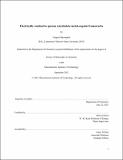Electrically conductive porous catecholate metal-organic frameworks
Author(s)
Skorupskii, Grigorii
DownloadThesis PDF (15.30Mb)
Advisor
Dincă, Mircea
Terms of use
Metadata
Show full item recordAbstract
Metal-organic frameworks (MOFs) are porous crystalline solids made up from countless possible combinations of organic ligands and metal nodes. MOF research has seen rapid expansion in the past two decades owing to the high surface areas of MOFs – and since the first studies in the mid-1990s, these materials have already found their first real-life applications in gas storage and separation. Of particular recent interest are electrically conductive MOFs, seen not only as porous conductors, but also as designer conductors thanks to the high degree of control over their structures. In this thesis, we attempt to improve our understanding of charge transport in MOFs by focusing on the compounds of 2,3,6,7,10-11- hexahydroxytriphenylene (H₆HOTP), which is essentially a trimerized 1,2-dihydroxybenzene, or catechol.
Chapter 1 introduces basic concepts of electrical conductivity in MOFs and explores in detail the current state of experimental investigations into record-setting two-dimensional (2D) conductive MOFs with extended π-d conjugation throughout the layers. Chapter 2 challenges the common assumption that this extended conjugation is the primary pathway for conduction in these materials: we explored MOFs based on the lanthanides (Ln) and H₆HOTP, Ln₁+ₓHOTP (x ~ 0.2) with no in-plane conjugation, and found that high conductivities could be achieved only through π-π stacking interactions of the organic linkers. Chapter 3 supports the findings of Chapter 2 with another new 2D conductive MOF, Ga₉HOTP₄. We found that despite little electron delocalization within the 2D layers, Ga₉HOTP₄ possesses conductivities matching those of its heavily delocalized transition-metal analogs, and that the conductivity similarly originates in ππ stacking. In Chapter 4, we find that high quality crystals of La₁.₅HOTP and Nd₁.₅HOTP are one-dimensional metals with record-high conductivities surpassing 1000 S/cm at room temperature. Importantly, the crystals also transition to a charge density wave phase below 370 K – such transitions are characteristic to one-dimensional metals and have not been reported previously for MOFs or any other porous solids. Lastly, in Chapter 5, we present a novel family of conductive MOFs based on rare-earth metals and H₆HOTP with isotropic cubic structures – a feature that is surprisingly rare in conductive MOFs.
Date issued
2021-09Department
Massachusetts Institute of Technology. Department of ChemistryPublisher
Massachusetts Institute of Technology